If I had to rank my favorite Magic: The Gathering artists, Amy Weber and her buoyant, diagrammatic compositions would be somewhere in the top three. What exactly are we seeing in Curse of Marit Lage? How does it relate to the card's in-game effect? Who knows! But it sure is fun to look at.
I really miss old Magic art. In the mid-1990s, Wizards of the Coasts' artist coterie was full of people whose work was impossible to mistake fom anyone else's. Amy Weber, of course. Richard Kane Ferguson. Kaja and Phil Foglio. Drew Tucker. Rebecca Guay. Andi Rusu. Even that deranged nazi fuck Harold McNeill. In its early years, Magic's signature "look" was a composite of diverse art styles, imbuing the fantasy world depicted in the cards and the aesthetic experiences of the game they're used in with a touch of surreality, of the protean, of...well, magic.
Scrolling through these writeups and just looking at the card images is sort like watching a time-lapse video of a flower blooming or a carcass decomposing. By the time we get to the end of the decade, the art doesn't look very much at all like it did at the beginning. After another eight years, the difference between Mark Poole's Counterspell and Jason Chan's Counterspell is as stark as the contrast between how Jack Kirby and Jim Lee drew the X-Men. Nowadays, Magic art is sleek, consistent, and exquisitely polished—but not as much fun as it was when it was still a hodgepodge, and before Wizards ran its art department like a factory.
...Anyway. Let's get on with it.
___________
Fallen Empires (November 1994) was where I hopped aboard the Magic train. My college-aged cousin Justin introduced me to the game during a visit. All the time I spent playing Final Fantasy and
World of Xeen equipped me to pick up the rules after only a game or two, and I had a blast. I can't say how much time passed between that fateful weekend and the afternoon I found a bunch of Fallen Empires booster packs for sale at a flea market, but I remember being
really stoked to buy them—and then wondering why
these cards had symbols below the pictures, and how I was supposed to play if none of the packs contained any lands. My friend and I pooled the cards into a stack and used pennies for lands; every turn we'd draw a card from the stack, and put a coin down as an all-color land. Ah, memories.
Because so much of Fallen Empires' flavor text consists of excerpts from a multi-volume historical tome titled Sarpadian Empires, we're to understand that we're once again looking into Dominaria's past. This time, the focus is on a continent called Sarpadia, which suffered a destabilizing climate change event. As each of Sarpadia's civilizations are brought low from war or implode from within, the destruction of one exacerbates the threats that imperil the others. It's grim stuff—and eerily ahead of its time. Fallen Empires came out well before the outlook on global warming intensified from "maybe it could be a problem" to "this is an existential threat to civilization that our body politic is incapable of averting all is lost we're doomed what difference does anything make oh god oh god."
After the narratively skimpy Legends and The Dark, Fallen Empires returns to the storytelling approach which Antiquities used to such effect. Compared to scanty but suggestive information given about the Brothers' War, the register of events leading to the collapse of Sarpadian civilization is fairly exhaustive. Even so, Fallen Empires' lore didn't stoke players' imaginations quite the way Antiquities' had. Maybe there were too many different factions in Sarpadia and too few prominent figures in any of them; maybe there was such a surfeit of information that the whole thing seemed more like an academic matter than one of high fantasy; maybe it simply lacked the archetypic punch of a brother-against-brother conflict.
Fallen Empires has two worldbuilding innovations to its credit. The first its experiment with "tribes," where it once again takes after Antiquities. The colored cards in that set were each associated with a particular faction, even if those factions weren't necessarily well-defined. Neither Legends nor The Dark followed suit in that regard, but Fallen Empires returns to that design space. Each color is dominated by two or three creature types. Curiously, the colors aren't so much at war with each other as with themselves: Red represents the dwarven cities and the orcs and goblins that laid them low. Blue represents the merfolk of Vodalia and the Homarids (lobster people) that thrived in the cooling climate and overwhelmed them. Green represents the elves of Havenwood and the fungoid-animal "thallids" they raised as cold-resistant food stock, and which eventually swarmed out of control. And so on.
Fallen Empires' other innovation was printing variants of common and uncommon cards—lots of variants, and by as many different artists. In this untried medium, experimentation with worldbuilding wasn't limited to the textual. With multiple artists envisioning the same entities and events, and apparently without a shared style guide, Fallen Empires synthesizes a history that's almost as misty as Antiquities', despite the higher clarity and thoroughness of its narrative.
What I mean is: the famed
Juzám Djinn from Arabian Nights is imagined to look precisely how he looks, because there is only the one single image of him, serially reproduced on thousands of cards. If you said "Juzám Djinn" to an inveterate Magic player circa 1995, the horns, the grin, the nose ring, etc. would have immediately popped into his or her thoughts. That wouldn't have been the case with, say, Fallen Empires' Thorn Thallid. They might think of a turtle-like chimera with a proboscis (above),
a mushroom with tentacles,
a greenish, murky humanoid,
or a Lovecraftian abomination. The Thorn Thallid is any one of them. It's
all of them! It's canon!




This was the last time Wizards printed variants on this scale for a long time. (When it resumed, the variants were super-sexy, super-rare alternates of already rare cards, to the delight of the secondary market.) I've read that people complained about Fallen Empires' variants stalling games because somebody kept having reach across the table to examine any one of the four printings of Hymn to Tourach or Goblin Grenade he didn't recognize on sight.
But there's another problem. Look at Phil Foglio's cartoonish take on the Goblin Chirurgeon (above, lower left). Somebody who'd been playing Magic for a while in 1994–5 would know right away that the goblin's patient is composed of a Llanowar Elf's head, an Uthden Troll's arm, and Jedit Ojanen's torso. Printing cards with alternate artwork undermines the design convention that makes Foglio's joke work. Llanowar Elves, Uthden Troll, and Jedit Ojanen were iconic among the cardflopping community—and by definition, iconography entails the standardization of identifying features. A card with three or four versions that look wildly different doesn't become strongly fixed in people's consciousness the way a card with a distinct and singular illustration tends to. It can't become iconic.
This isn't the sort of thing that really matters in terms of how the game is played. Hymn to Tourach was still a broken card that inspired terror and loathing, and saw frequent use as a result. But in the ghostly space of recollection and meta-lore, it doesn't have the epochal significance of
Hypnotic Specter or
Mind Twist—cards that did pretty much the same thing, and did it at least as well, but had only one image associated with their names and functions.
The release of Ice Age (June 1995), Magic's first stand-alone set, was a milestone. Until then, expansions sets were only buyable in small booster packs, while starter decks (the boxes that came with sixty cards, including lands, and a rulebook) were all from the core set—which had already undergone four different iterations by this point. Ice Age was like a separate core set, sold in booster packs and starter decks, that had its own prints of basic lands, reprints of indispensable common cards from the core set, and version of the rulebook. This...probably doesn't sound terribly important to anyone who's not familiar with the economy of Magic set design and release, but any change in the template in which content is packaged for consumption influences how that content is developed.


The name of the set is self-explanatory: Dominaria experienced (once again, past tense) an ice age. Some centuries after the onset of the year-round winter, several fairly advanced societies have risen on the continent of Terisiare. Unlike Antiquities or Fallen Empires, Ice Age doesn't convey a sense of strife or crisis, but of a tenuous stability. While there are ambitious actors and societies skirmishing over territory, Ice Age feels something like a peep into an order that's emerged from chaos, rather than one that teeters on the brink of it. We see the (perhaps) unconscious influence of the Dungeons & Dragons module on Magic's worldbuilding writ large: Ice Age presents us with a conceptual map of a fantasy realm with its heroes, villains, cities, landmarks, and conflicts, but the story that emerges from their aggregation begins and ends in media res. Implicitly, it's up to the player to decide what happens.
As in Fallen Empires, each color is associated with one or another of Terisiare's factions and/or ecological zones, though the borders are fairly permeable. White mostly represents the nation of Kjeldor, Terisiare's undisputed superpower. Red has to do with the "barbarian" peoples of the Karplusan mountains, the troublemaking orcs and goblins, and one particular shit-talking mercenary wizard. In addition to the frozen woodlands and their various critters, the green contingent comprises the human druids and elves of the Fyndhorn forest, united in their worship of the goddess Freyalise (actually a planeswalker). Blue is composed of wizards and artificers of every allegiance, including the School of the Unseen and an apostate enchanter named Zur. Black mostly represents the forces of Lim-Dûl the Necromancer, but also contains an order of Kjeldoran supremacists, weirdos from a city called Krov, and the occasional cultist of a deity called Marit Lage, characterized in terms liberally borrowed from Lovecraft.
At 383 cards, Ice Age is over three times bigger than Antiquities and The Dark, and almost twice as big as Fallen Empires. Its designers took advantage of this ample space to flesh out a diverse scenario populated with major and minor figures, rivalries, and regions. Ice Age has as palpable a mood as The Dark and as intriguing a cast as Antiquities, and it improves on Fallen Empires' modality of panoramic narration. One such improvement was only sparingly using excerpts from its own fictional history book (Kjeldor: Ice Civilization) to set the scene, and relying more on quotations from a regular cast.
Ice Age's two standout characters are, without doubt, Lim-Dûl and Jaya Ballard. The first is very obviously the set's big bad: a power-hungry necromancer who has embarked on a campaign to enslave and/or kill everyone in Terisiare (as evil wizards are wont to do). Like Urza and Mishra, we never see Lim-Dûl; unlike the titular siblings of the Brothers' War, he's characterized solely by the weird, scary shit he says rather than through the narration of a fictional historian. It almost feels inappropriate to use the word "characterization" with regard to Lim-Dûl. Like most figures from early Magic sets, he functions less as a character than an ambiance.




Jaya Ballard, on the other hand, is some sort of bounty-hunting fire mage who likes to snark as she blows shit up. She's only quoted on a handful of cards, but nevertheless became a fan favorite who ended up lasting far longer than Lim-Dûl in the annals of Magic. I have to wonder, though: was she popular because her quips were extraordinarily brilliant in and of themselves? Because they happened to appear on several strong cards that saw a lot of use? Or because of some hard-to-quantify gestalt of the illustrations, the quotes, and their aptness to the cards' effects in play? I'm sure that latter-day corporate Wizards of the Coast has given a lot of thought to this sort of thing—but I'm not privy to their research.
(Funny side note: Jaya's gender is never actually mentioned. Evidently she was going to appear as a male in an Armada comic that got canned in the planning stages. I'll admit that I assumed she was a dude until I stared at the Pyroblast card enough times to start associating the speaker in the flavor text with the woman in the art. The same thing happened after I used the Ice Age print of Dark Ritual a few hundred times: I started picturing Lim-Dûl as the fella in the middle.)
Neither The Dark nor Fallen Empires had any legendary cards; maybe the developers thought of it as a gimmick that ought to be restricted to the set where it was introduced. Ice Age brings them back, and it seems almost as though it was a reluctant, or at least a cautious choice.
There are four legendary creatures in Ice Age. Only one of them (General Jarkeld) is a member of the flavor-text chorus, but he's dead—perished "long ago" according to Lost Order of Jarkeld (above), and his last words are quoted on
Rally. There's also one Márton Stromgald: he's not quoted or even mentioned anywhere in Ice Age, though an order of ultra-nationalist Kjeldoran knights apparently named itself in his honor. (See Knight of Stromgald, above.) We can infer that he's been dead for a while, too—which places the world of Ice Age in a wide and perhaps uncertain temporal frame.
Then there's Merieke Ri Berit, whose name is almost certainly an acronym, and has no backstory or significance that I can discern. And the Skeleton Ship is...well, it's a legend. Of a ship. With skeletons. Skeletons that fly around on sea turtles. (Have I mentioned how much I enjoy and miss Amy Weber's art?)
The fact that Ice Age put legendary cards back on the table (so to speak), but in such a small number, and representing only one figure who ever speaks or is spoken of, suggests to me that the designers had Antiquities on the brain. At that time, Urza and Mishra were regarded as the de facto main characters of Magic lore (because who else
was there?), and it stood to reason that they'd sparked such interest
because they were concealed from view and left up to players' imaginations. By that line of reasoning, it made sense to take the same approach with the personalities of Ice Age, keeping Lim-Dûl, Jaya Ballard, Arna Kennerüd, et al. behind a curtain. Disclosure and mystique are often mutually exclusive.
On the topic of of Urza and Mishra, Ice Age introduces something to Magic that we haven't seen yet: continuity. Fallen Empires' events were linked to climate change, but as far as we knew, it might have been a natural and relatively isolated phenomenon. Ice Age reveals that Sarpadia's bane was indeed a global event, and strongly implies not only that the Brothers' War was the cause, but that Terisiare was the artificer siblings' main battlefield.
Most of Ice Age's references to the events of Antiquities appear in the arguments from an ongoing dispute between one Arcum Dagsson, a researcher seeking to use and reverse-engineer lost technology, and one Sorine Relicbane, an outspoken luddite. It seems that the passage of centuries (or millennia?) has done nothing to efface Terisiare's memory of the Brothers' War.
Next is...oh, lord. I guess we have to say a few words about
Homelands (October 1995).
All these years later, Homelands still stokes controversy among Magic obsessives. On one side of the debate are those who say that Homelands is a huge pile of garbage with no redeeming qualities whatsoever. Others disagree, contending that Homelands is a huge pile of garbage with some redeeming qualities.
I belong to the second camp. As game pieces, nine of of ten Homelands cards were useless at the time, and have gotten even worse with age. But in terms of narration and flavor, the set was truly ahead of the curve.
The long and short of the plot: centuries ago, the plane called Ulgrotha was the site of a devastating war between two planeswalker factions. Some years after the ashes settled, the planeswalkers Feroz and Serra (namesake of the Serra Angel) took on the responsibility of nurturing Ulgrotha back to life and preventing other planeswalkers from barging in and throwing their weight around. Their presence checks the tyrannical ambitions of Baron Sengir (namesake of the Sengir Vampire), who aspires to rule Ulgrotha after a planeswalker summoned him and left him stranded there long ago. Then Feroz and Serra died, leaving the plane at Sengir's mercy. Or is it...?
Homelands, then, was the first set that took place on a plane other than Dominaria (before any retconning), the first where planeswalkers are quoted in flavor text, and the first which centers meddling planeswalkers in its backstory. It was the first whose action was intended to be understood as taking place in the present. It was the first set whose accompanying publication (an Armada Comics one-shot) was mandatory reading for anyone who wanted to better understand the story in the cards—which would become the norm by the end of the decade. And it was the first time virtually every important figure in the plot got a legendary card, which was hard not to get excited about.
Let me remind you that in 1996 you couldn't log onto the internet and be skimming a comprehensive, pictorial index of the latest Magic expansion within thirty seconds. Unless you were buying and reading issues of the Duelist or InQuest, you had no idea what was in Homelands, or what the extent of it was. So you can imagine how shocked I was the first time my cousin dropped Eron the Relentless on the table during one of his weekend visits.
"Eron the Relentless?" I gasped, recognizing his name from the flavor text of several cards in my collection. "That's him? He's real?"
Yes, he was quite real—and he stomped my ass. All things considered, though, my introduction to Eron was far less traumatic than my first meeting with Autumn Willow at the Arena League some months later. (There was a handful of decent cards in Homelands, two of which were Eron and Ms. Willow. Neither is much of a contender these days, though.)
Similar to Ice Age, Homelands maps out a scenario more or less the way a Dungeons & Dragons module would, detailing the relevant history, major players, and conflicts of its world as though a pause button were hit at a pivotal moment in time—that time being when the magical barrier Feroz threw up to lock out other planeswalkers has faded away at last. Now you, the player/planeswalker, can visit Ulgrotha and decide its destiny, etc. etc., for just three bucks per eight-card booster pack!
This is probably why the set gives no indication of how things turn out in the end. A Dungeons & Dragons module that provided resolutions in advance would be pretty pointless for a roleplaying campaign, wouldn't it?
Two other things are worth mentioning about Homelands. The first (mentioned by
Multiverse in Review) is that one of its main designers became Wizards' envoy to Armada Comics. This probably explains why Taysir, the planeswalker at the center of the Arabian Nights comic (released two months after Homelands dropped), joins the flavor text chorus.
(Momentary digression: I'm not sure how many people were actually reading the Armada comics back in the day, or how seriously they were taken. I remember picking an issue of Antiquities War from the spinner rack, leafing through it, and regarding it as I did Archie Comics' take on Sonic the Hedgehog: as third-party apocrypha. Modern-day Wizards has shown itself equally willing to acknowledge characters and events from the Armada comics as to quietly retcon them, when either is convenient.)
The second Homelands factoid: the set gives variant art another chance. This time, there are only two pieces of alternate art per card, both by the same illustrator, and often representing the left and right halves of a single picture. The results are pretty dull: what's the point of variety if it ends up being redundant? The alternates are only interesting when card A and card B each quote a pair of characters with antipodal points of view (which doesn't happen nearly enough), or when Susan Van Camp serves up cheesecake for fanciers of both men and women (which there should have also been more of).
At any rate, I found Homelands' lore so engaging, and was still so ignorant about the do's and don'ts of building Magic decks in late 1995/early 1996 that I amassed a bloody truckload of the damn cards before realizing how utterly worthless most of them were in play. I'm not proud of it.
The last set we'll be glancing at today is Alliances (June 1996). Hard to believe that everything we've covered so far came out in the span of just three years, isn't it? (Hopefully things will speed up once we get to a point where the sets are designed and marketed as tripartite blocks. God I hope so.)
And just look how much the art has improved since the beginning! Alliances was the first of four sets where the controversial Sue Ann Harkey served as art director. I know very, very little about the behind the scenes bickering and the occasional airing of dirty laundry—I just know that three of the four sets she oversaw are some of the best-looking in the Magic library.
Alliances is on the border of two different periods of Magic art. It features new talent like
Terese Nielsen,
Randy Gallegos, and Rebecca Guay (and also a guest appearance by Bill Sienkiewicz, best known for his work on X-Men spinoff The New Mutants), but is also the last hurrrah for several familiar artists, including a few of the original twenty five:
Sandra Everingham, Andi Rusu,
Anson Maddocks,
Julie Baroh, and Amy Weber all jumped ship after Alliances. (Wizards changed how it did business with artists—buying the copyrights to new work so as not to pay royalties in perpetuity—and some took the news worse than others.) Alliances' illustrations are a mixture of contributions from the artists who defined Magic's visual identity during its infancy, and from the ones brought on to raise the bar, and they harmonize wonderfully. Under Harkey's direction, the overall aesthetic strikes an admirable balance between consistency and phantasmagoric plasticity.
On that note: Alliances gives Homelands' approach to art variants one last try, and the outcome is only slightly less underwhelming. Sometimes the alternate versions depict a "before" and an "after" instead of just combining to present a wider scene, which is sort of neat. But once again, the variants are most interesting when their flavor text poses a point and a counterpoint, or when Susan Van Camp is doing her thing.
What makes Alliances a landmark was how it was marketed: Wizards sold it not just as another Magic expansion, but as an expansion to the stand-alone set Ice Age. This probably doesn't make much sense to anyone who hasn't played Magic, but players in 1996 recognized that this was unprecedented and unusual. This inaugurated the production model to which Wizards would adhere for nearly two decades: release one large standalone set, followed by two small sets that are narratively and mechanically related to it. Rinse, repeat, print money.
Ice Age was the first Magic set to make explicit its narrative continuity with an earlier set; Alliances was Magic's first direct sequel. Apparently during Ice Age's peep into Terisiare, the planewalker Freyalise was preparing to cast a massive global warming spell because enough was enough. Twenty years have passed, and the end of the centuries-long winter has brought some unintended consequences: flooding, displacement, disease, lobster people. The nation of Kjeldor and the Balduvian tribes have formed an uneasy alliance (cue title card!) to confront their mutual challenges, but a rogue Kjeldoran general intends to shatter the fragile peace. Driven from their inundated home, the elves and human druids of Fyndhorn seek refuge in the Yavimaya Forest, which is apparently possessed of a hostile hive-consciousness. Merfolk arrive from abroad to investigate the appearance of Viscerids, descendants of the Homarids that wiped out their Sarpadian kin. And so on. (I was a little surprised to learn that the backstory was developed completely ad hoc: the cards were designed first, and the lore was grafted onto them afterwards.)
This is also the first time that a Magic expansion's raconteurs return for an encore. Lovisa Coldeyes, Arna Kennerid, Halvor Arensson, and Gerda Äagesdotter, are all still alive and gabbing. Disa the Restless isn't so lucky. Zur and his followers seem to have disappeared. Lim-Dûl is mysteriously absent, leaving his undead minions to sulk and sharpen their knives in his old fortress. (I think that his fate might be addressed in the comic books, which might have been retconned later on by the novels. Before long we'll have to talk about the problems and benefits of splitting the narrative between the cards and secondary sources, whether published in-house or by third parties.)
At any rate, we were all certainly relieved to learn that Jaya Ballard had survived the political and environmental turbulence of the thaw and was still setting people on fire.
Alliances introduces several new voices—King Darien and General Varchild, most importantly—but after Homelands, it seems rather odd that neither they nor the returning figures from Ice Age are represented in legendary cards.
Of the set's three legendary creatures, only Kaysa speaks or is spoken of in the flavor text. The Lord of Tresserhorn is, we can only assume, the substitute ghoul running things in Lim-Dûl's's absence, and Phelddagrif is, uh, a flying purple hippopotamus whose name is an anagram of "Richard Garfield, PhD." No explanation is given.
(The Storm Crow is a legend unto itself. Just take my word for it, unless you're in the mood for a deep dive into the memes of Magic message boards.)
Meanwhile, Alliances continues to grow the prestige of Magic's OGs. Urza, Mishra, and Ashnod from Antiquities each gets a new card to their name. Lat-Nam, the wizards' college associated with Drafna and Hurkyl appears in a few cards, too. Seems it's easier to conduct excavations when the ground isn't frozen.
But the most significant Brothers' War throwback is the presence of Phyrexia, which Antiquities dimly characterized as maybe, possibly, a swords n' sorcery version of
Robot Hell. Armada's Antiquities War comic verified that assumption, very probably at Wizards' direction. (The designers of Antiquities, you'll remember, drafted far more lore than made it into the cards.) I can't speak for anyone else, but I was happy to see more of Phyrexia. Despite it being such a minute part of Antiquities, the concept of a hellish metal landscape where grease grained from the sky made a powerful impression on the imagination.




Alliances' Phyrexia arc is unique among the set's several subplots in that it is an arc. Whereas Varchild's insurrection and the elves' adjustment to Yavimaya are suspended in the familiar media res idiom of Ice Age and Homelands, Arcum Dagsson's excavation of Phyrexian technology, his cautious attempts to put it to use, and the robots' running amok and wrecking his home city are narrated almost from beginning to end through quotations from Dagsson and his perennial critic Sorine Relicbane as they resume their "Point-Counterpoint" session from where it left off in Ice Age.




One final thing I'd like to draw attention to is a pair of cards that shows Magic's designers beginning to understand how the "language" of the game's rules can be used to supplement its lore. Back in Antiquities, there was a card called Priest of Yawgmoth whose ability let you break one of your artifacts for an injection of spellcasting fuel. In Alliances, where there seems to be dark business afoot in the depths of Soldev, we meet the Soldevi Adnate. His attributes are identical to the Priest of Yawgmoth, and his ability does almost the exact same thing—except he (or she, depending on the variant) sacrifices creatures for juice. It's a subtle, clever way of cluing the attentive loremonger in to what's going on (Dagsson's experiments with ancient Phyrexian machinery coincide with the appearance of some sort of Yawgmothian death cult in Soldev's underbelly) without announcing it in writing.


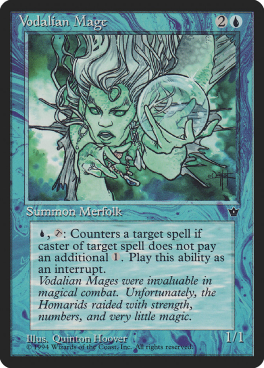

























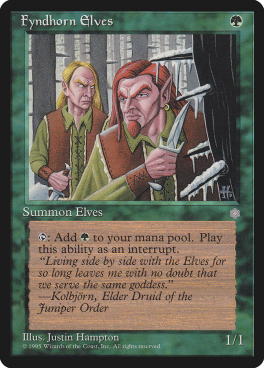

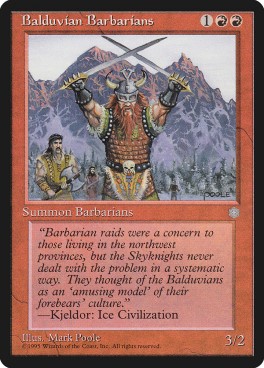


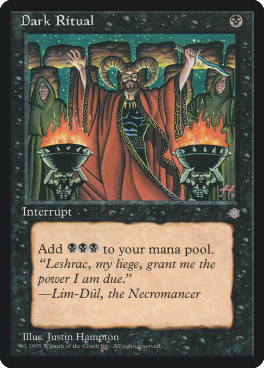





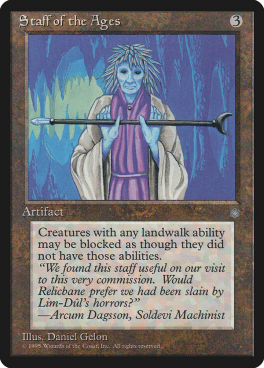


















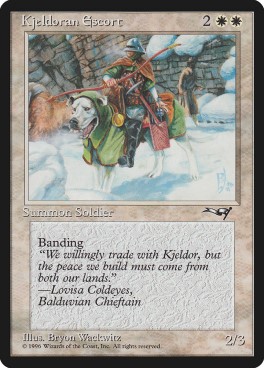





































Magic: The Gathering: The Worldbuilding: The Writeup: The Anonymous Comment 2
ReplyDelete"So you can imagine how shocked I was the first time my cousin dropped Eron the Relentless on the table during one of his weekend visits.
"Eron the Relentless?" I gasped, recognizing his name from the flavor text of several cards in my collection. "That's him? He's real?"
Was this the moment that you truly felt like a planeswalker? I imagine that world felt so real to you that this revelation had a profound impact.
Lots of other great stuff in this post, but not the time to comment.
I guess it did—but I was, what, twelve years old? Seemingly trivial things have profound impacts at that age. Charlie being in Street Fighter Alpha had me reeling. I lost sleep when Legion killing Professor Xavier and destroyed the timeline because I thought it was going to be permanent.
DeleteI'm not sure whether I was a weird kid or if exposure to pop culture made me weird.
Its the kid thing. When we're young we're always blown away ny anything we encounter that's the first of its type to us. I first saw 2001 when inwas 14. Thought it was a revelation on par with the Bible or Babylonion Steel. Only when we're older we realize that all these childish things are just a hack of a hack of a ghost of the real thing.
ReplyDeleteThats part of why I refuse to replay old videogames i loved as a kid. Nostalgia only exists when remembered, not relived. That new experience supplants the old and that magic memory is gone forever.
That was a great read thanks.
ReplyDeleteWelp, I think we're getting close to the Mirage set, which is the last time I bought cards and when I stopped caring about Magic. Anyway, I liked it better when the art was less streamlined fantasy stuff and the quotes were from real authors and not from "Xyrguzk the Blade Whisperer, Last of the Maidens of Xorkhan the hkyyzkmlgt..."
I just finished Elden Ring and you made me realize it's basically the same thing as Magic, except item descriptions are the equivalent of cards. It's just a bunch of free-floating "lore" without any plot or meeting any of the mentioned characters, give or take a few boss fights. Is raw lore that interesting? I suppose it's a nerd thing?
It's like reading placards explaining random objects in an ancient history museum, except, well, not real. I guess that's what archeology feels like and must be the appeal of this kind of "free-floating lore" approach to worldbuilding. History can only be seen through random artifacts and has no "plot". I'm currently reading a book on Roman society and the authors are surprisingly upfront about not really knowing anything. Every chapter is basically like: "We've rounded up a few quotes from Cicero and Pliny the Younger, plus some random funeral inscriptions, and we can maybe assume winemaking was not profitable. Or maybe it was."